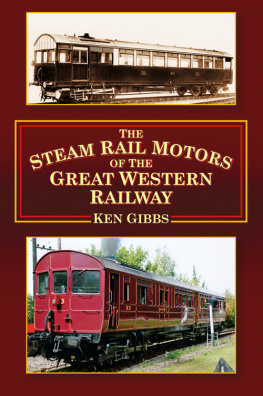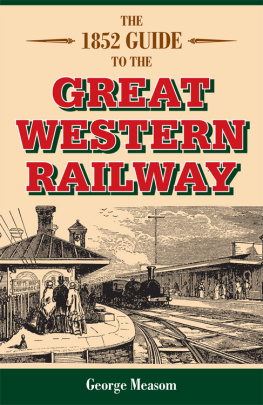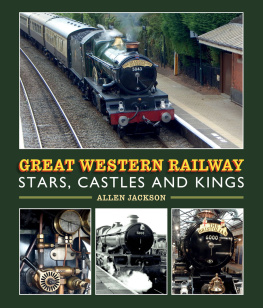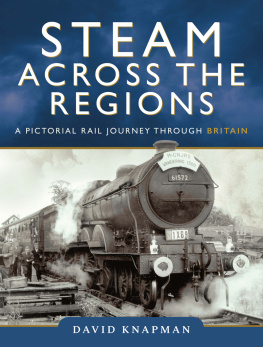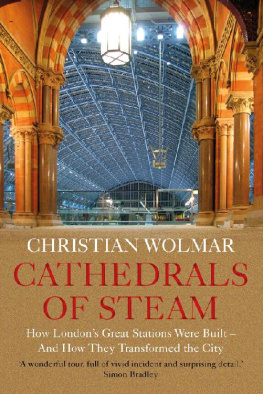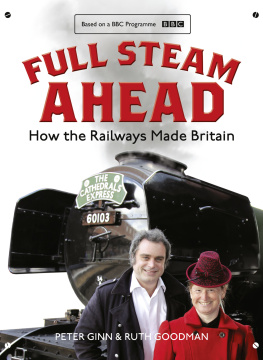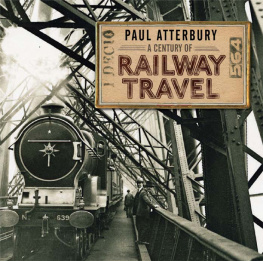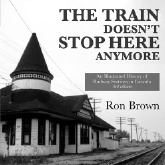Ken Gibbs - The Steam Rail Motors of the Great Western Railway
Here you can read online Ken Gibbs - The Steam Rail Motors of the Great Western Railway full text of the book (entire story) in english for free. Download pdf and epub, get meaning, cover and reviews about this ebook. year: 2015, publisher: The History Press, genre: Non-fiction. Description of the work, (preface) as well as reviews are available. Best literature library LitArk.com created for fans of good reading and offers a wide selection of genres:
Romance novel
Science fiction
Adventure
Detective
Science
History
Home and family
Prose
Art
Politics
Computer
Non-fiction
Religion
Business
Children
Humor
Choose a favorite category and find really read worthwhile books. Enjoy immersion in the world of imagination, feel the emotions of the characters or learn something new for yourself, make an fascinating discovery.
- Book:The Steam Rail Motors of the Great Western Railway
- Author:
- Publisher:The History Press
- Genre:
- Year:2015
- Rating:3 / 5
- Favourites:Add to favourites
- Your mark:
- 60
- 1
- 2
- 3
- 4
- 5
The Steam Rail Motors of the Great Western Railway: summary, description and annotation
We offer to read an annotation, description, summary or preface (depends on what the author of the book "The Steam Rail Motors of the Great Western Railway" wrote himself). If you haven't found the necessary information about the book — write in the comments, we will try to find it.
Ken Gibbs: author's other books
Who wrote The Steam Rail Motors of the Great Western Railway? Find out the surname, the name of the author of the book and a list of all author's works by series.
The Steam Rail Motors of the Great Western Railway — read online for free the complete book (whole text) full work
Below is the text of the book, divided by pages. System saving the place of the last page read, allows you to conveniently read the book "The Steam Rail Motors of the Great Western Railway" online for free, without having to search again every time where you left off. Put a bookmark, and you can go to the page where you finished reading at any time.
Font size:
Interval:
Bookmark:


Assistance in compiling this work has come from a number of sources.
The great contribution by Dr Ralph Tutton formed the basis for the rebuild of No. 93. Also thanks to Tim Brian (then Curator of STEAM, the Museum of the Great Western Railway) who first pointed me in the direction of Dr Tuttons archive material. John Walter, who had additional engineering drawings listed on his computer and who again pointed me to the sources and obtained some of the prints for me.
To the Great Western Society at Didcot and to STEAM, The Museum of the Great Western Railway, for access to their archives.
Photographs are by the author unless noted otherwise.
I also have a personal connection with No. 93 both before and during the rebuild project.
My sincere thanks to all.
Ken Gibbs LCGI (Mech Eng)

No. 93 sole survivor. (Photo D. Feltham)
The last steam rail motor was taken out of service when I was about five years old, so although coming from a railway family in a railway town, I didnt see one actually in use.
From school, a completed apprenticeship at Swindon Works was followed, with thousands of others, into the RAF. On demob a couple of years back on the shop floor was followed by promotion to the supervisory staff and secondment into a firm of productivity consultants just introduced to the Works (1955). It was then that I first had contact with a steam rail motor, or at least with a rail motor converted to a trailer car, and then again converted to a mobile office, positioned on a rail line directly outside the C&W Department office block at Swindon Works. The coach was subsequently moved around the Western region with me and a team for about three years, when I was once more returned to Swindon Works and the coach went on its way. Then I lost touch.
Through a working life, I had just retired (1983) and joined the Great Western Society where at Didcot I was reintroduced to my old mobile office (then as a stores for various railway items) scheduled for rebuilding into a working steam rail motor, the only survivor of its fellows. It is now fully operational and heading for a second life. I have long been involved with the dedicated groups working for the rail motor and other locomotives at Didcot, and thus the coach saga and my career seem to have turned full circle even in retirement!
A transport innovation at the beginning of the twentieth century created great interest in many of the worlds railways. The carriage with a steam engine in one end captured imaginations, none more so than the Great Westerns. The birth of the steam rail motor was seen to herald a revolution in rural transport.
Its introduction on the Great Western was an astonishing success, opening up villages and market towns with potential additional travelling facilities. The problem was it was too successful, opening up a market with which the steam rail motors could not cope, a situation which soon became very obvious when required loads proved too much for the small power units, although they could handle a trailer car.
If something went wrong with the steam power unit, or with the carriage section, the whole rail motor was off the schedule and a new thinking was required for the whole system. So started the conversions! After being in operation for five or six years only, selected rail motors had the steam unit removed, the carriages converted to trailer cars now powered by a small, separate locomotive that could also be used independently, for example shunting wagons, which the rail motor could not really take.
In the period 191418, war retarded the conversion programme to a degree, but following the war, by the early 1930s, the steam rail motor on the Great Western was history.
This book covers the Great Westerns involvement in the rise and fall of the steam rail motor and a century later, a steam rail motor rebuild. But read on!
Businesses the world over have been and are still always on the lookout for ways of cutting costs. In this respect the railway systems of Britain and the world were no exceptions. In the first flush of railway building, many routes were established that, as time went by, although essential and to a reasonable extent still profitable, were still thought to be capable of further economies, and exertions were made to determine suitable means. All this was against a rising tide of opposition in the burgeoning field of road motor transport. As various railways continued to experiment with the old idea of the self-contained powered coach, and after trying out a borrowed example, the Chairman of the Great Western, Earl Cawdor, announced to the 13 August 1903 meeting of shareholders:
We are putting on a motor car service, a combined car which will carry fifty-two passengers. This car will run on the rails of our own line. We are putting on one now and it will be working in October between Stonehouse and Chalford in the Stroud Valley. We can run this car on the line, stopping not only at stations, but with the sanction of the Board of Trade, at level crossings and at roads coming up to the line This motor car will be working by steam, there are others which are worked by petrol, but we have decided on one propelled by steam, and we hope it will be running by next October.
As good as his word, two cars started the run on 12 October 1903. There were four stops besides the Brimscombe and Stroud stations, but difficulties were soon experienced with passenger access and egress at the four intermediate stops. Down to ground level was quite a drop and the collapsible iron steps provided for this purpose (controlled from inside the car by a lever) were soon found to be rather inconvenient, particularly for long-skirted lady travellers. So, in this respect it was back to the drawing board, and the raised Halt platform was proposed, an innovation detailed later in this book. However, the inaugural run was very successful and the invited distinguished guests and a host of reporters were well satisfied. Those attending the run included Mr G. Churchward (Loco & Carriage Superintendent), Mr W. Dawson (Outdoor Assistant Superintendent), Mr C. Aldington (representing the General Manager Mr J.C. Inglis), Mr Marillier (Carriage Department), Mr Simpson (of the Superintendent of the Lines Office) and Mr W. Waister (Locomotive & Carriage Running Department). The accompanying journalists were mainly from London and Gloucester and all were entertained to lunch on their return to Swindon. A short speech from Mr Dawson thanked those who attended the launch of the project and a reply from The Times representative wished the project every success.
A further snippet of information from The Stroud Journal & Cirencester Gazette of Friday 9 October 1903 mentioned receipt of the official rail motor timetable. Starting from Chalford at 8 a.m. and from Stonehouse at 8.30 a.m. the motors ran an hourly service up to 10.30 p.m. from Chalford and Stonehouse 11.00 p.m., these two latter being late trains on Fridays and Saturdays. The return fare between Stroud and Stonehouse was 4 pence and between Stroud and Chalford 6 pence and the duration of actual travelling twenty-three minutes between six stops (St Marys Crossing, Brimscombe, Ham Mill Crossing, Stroud, Downfield Crossing and Ebley Crossing).
Next pageFont size:
Interval:
Bookmark:
Similar books «The Steam Rail Motors of the Great Western Railway»
Look at similar books to The Steam Rail Motors of the Great Western Railway. We have selected literature similar in name and meaning in the hope of providing readers with more options to find new, interesting, not yet read works.
Discussion, reviews of the book The Steam Rail Motors of the Great Western Railway and just readers' own opinions. Leave your comments, write what you think about the work, its meaning or the main characters. Specify what exactly you liked and what you didn't like, and why you think so.

